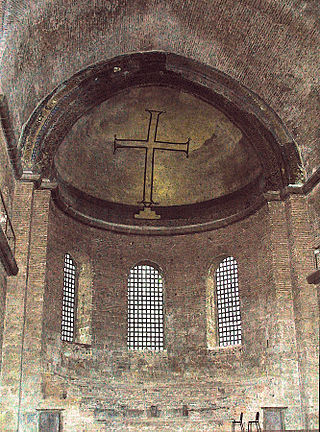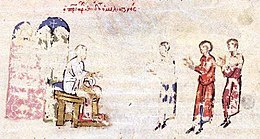
The Second Council of Nicaea is recognized as the last of the first seven ecumenical councils by the Eastern Orthodox Church and the Catholic Church. In addition, it is also recognized as such by the Old Catholics, the Anglican Communion, and others. Protestant opinions on it are varied.

Theodore the Studite, also known as Theodorus Studita and Saint Theodore of Stoudios/Studium, was a Byzantine Greek monk and abbot of the Stoudios Monastery in Constantinople. He played a major role in the revivals both of Byzantine monasticism and of classical literary genres in Byzantium. He is known as a zealous opponent of iconoclasm, one of several conflicts that set him at odds with both emperor and patriarch. Throughout his life he maintained letter correspondences with many important political and cultural figures of the Byzantine empire; this included many women, such as the composer and nun Kassia, who was much influenced by his teachings.

Nikephoros I or Nicephorus I was a Byzantine writer and patriarch of Constantinople from 12 April 806 to 13 March 815.

Leo V the Armenian was the Byzantine emperor from 813 to 820. A senior general, he forced his predecessor, Michael I Rangabe, to abdicate and assumed the throne. He ended the decade-long war with the Bulgars, and initiated the second period of Byzantine Iconoclasm. He was assassinated by supporters of Michael the Amorian, one of his most trusted generals, who succeeded him on the throne.

Germanus I was an ethnic Latin Patriarch of Constantinople from 715 to 730. He is regarded as a saint, by both the Orthodox and Roman Catholic Churches, with a feast day of 12 May. He had been ecumenically preceded by Patriarch John VI of Constantinople, and was succeeded in Orthodox rite by patriarch Constantine II of Constantinople.

Theodora, sometimes called Theodora the Armenian or Theodora the Blessed, was Byzantine empress as the wife of Byzantine emperor Theophilos from 830 to 842 and regent for the couple's young son Michael III, after the death of Theophilos, from 842 to 856. She is sometimes counted as an empress regnant, who actually ruled in her own right, rather than just a regent. Theodora is most famous for bringing an end to the second Byzantine Iconoclasm (814–843), an act for which she is recognized as a saint in the Eastern Orthodox Church. Though her reign saw the loss of most of Sicily and failure to retake Crete, Theodora's foreign policy was otherwise highly successful; by 856, the Byzantine Empire had gained the upper hand over both the Bulgarian Empire and the Abbasid Caliphate, and the Slavic tribes in the Peloponnese had been forced to pay tribute, all without decreasing the imperial gold reserve.

Tarasios of Constantinople was the Ecumenical Patriarch of Constantinople from 25 December 784 until his death on 25 February 806.
Iconodulism designates the religious service to icons. The term comes from Neoclassical Greek εἰκονόδουλος (eikonodoulos), meaning "one who serves images (icons)". It is also referred to as iconophilism designating a positive attitude towards the religious use of icons. In the history of Christianity, iconodulism was manifested as a moderate position, between two extremes: iconoclasm and iconolatry.

Methodios I or Methodius I was Ecumenical Patriarch of Constantinople from March 4, 843 to June 14, 847. He was born in Syracuse and died in Constantinople. His feast day is celebrated on June 14 in both the East and the West.
The iconoclast Council of Hieria was a Christian council of 754 which viewed itself as ecumenical, but was later rejected by the Second Council of Nicaea (787) and by Catholic and Orthodox churches, since none of the five major patriarchs were represented in Hieria. However it is preferred over Second Nicea by some Protestants.

John VII, surnamed Grammatikos or Grammaticus, i.e., "the Grammarian", was Ecumenical Patriarch of Constantinople from January 21, 837 to March 4, 843, died before 867. He is not to be confused with the much earlier philosopher John Philoponos.
Antony I Kassymatas Ecumenical Patriarch of Constantinople from January 821 to January 837.

Theodotos I Kassiteras, Latinized as Theodotus I Cassiteras was Ecumenical Patriarch of Constantinople from 1 April 815 to January 821.

Theodorus and Theophanes, called the Grapti, are remembered as proponents of the veneration of icons during the second Iconoclastic controversy. They were brothers and natives of Jerusalem.

The Byzantine Iconoclasm were two periods in the history of the Byzantine Empire when the use of religious images or icons was opposed by religious and imperial authorities within the Ecumenical Patriarchate and the temporal imperial hierarchy. The First Iconoclasm, as it is sometimes called, occurred between about 726 and 787, while the Second Iconoclasm occurred between 814 and 842. According to the traditional view, Byzantine Iconoclasm was started by a ban on religious images promulgated by the Byzantine Emperor Leo III the Isaurian, and continued under his successors. It was accompanied by widespread destruction of religious images and persecution of supporters of the veneration of images. The Papacy remained firmly in support of the use of religious images throughout the period, and the whole episode widened the growing divergence between the Byzantine and Carolingian traditions in what was still a unified European Church, as well as facilitating the reduction or removal of Byzantine political control over parts of the Italian Peninsula.

In the history of Christianity, the first seven ecumenical councils include the following: the First Council of Nicaea in 325, the First Council of Constantinople in 381, the Council of Ephesus in 431, the Council of Chalcedon in 451, the Second Council of Constantinople in 553, the Third Council of Constantinople from 680–681 and finally, the Second Council of Nicaea in 787. All of the seven councils were convened in what is now the country of Turkey.

The Fourth Council of Constantinople was the eighth ecumenical council of the Catholic Church held in Constantinople from October 5, 869, to February 28, 870. It was poorly attended, the first session by only 12 bishops and the number of bishops later never exceeded 103. In contrast the pro-Photian council of 879–80 was attended by 383 bishops. The Council met in ten sessions from October 869 to February 870 and issued 27 canons.

Symbatios, variously also Sabbatios (Σαββάτιος) or Sambates (Σαμβάτης) in some sources, was the eldest son of the Byzantine emperor Leo V the Armenian. Soon after the coronation of his father, he was crowned co-emperor and renamed Constantine. He reigned nominally along with his father until the latter's assassination in 820, after which he was exiled to Prote, one of the Princes' Islands, as a monk.
This is a timeline of the presence of Eastern Orthodoxy in Greece from 717 to 1204. The history of Greece traditionally encompasses the study of the Greek people, the areas they ruled historically, as well as the territory now composing the modern state of Greece.

The Council of Constantinople of 843 or the Synod of Constantinople of 843 was a local council of Christian bishops that was convened in Constantinople in AD 843 by the Byzantine regent Theodora. This council, convened to refute iconoclasm, is still celebrated on the first Sunday of Great Lent in the Eastern Orthodox Church, as decreed by the council. Attendees under the presidency of Patriarch Methodios I met on 11 March 843 and symbolically processed from the Church Blachernae to the Church of Hagia Sophia bearing an icon of the Mother of God.














